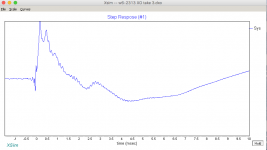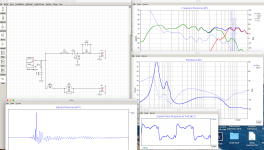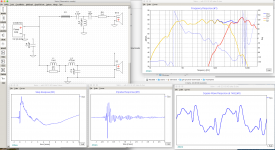^With tweeter's polarity inverted, that would be a nice LR2 step response... Have you tried and measured that? My guess is that inverted will show eleveted summed response around xo. Might sound better too...
You're crossing at about 4khz iirc ? With a dsp and an active crossover would you start lower or are there compelling reasons to go high anyway?
^With tweeter's polarity inverted, that would be a nice LR2 step response... Have you tried and measured that? My guess is that inverted will show eleveted summed response around xo. Might sound better too...
The tweeter is inverted in my measurements.
You're crossing at about 4khz iirc ? With a dsp and an active crossover would you start lower or are there compelling reasons to go high anyway?
Yes, I'm crossing that high because of the peaks on both the woofer and the tweeter. That's where I have the smoothest transition.
If you are going active, you will be able to take out those peaks and cross wherever you like.
I wouldn't go too low. Depending on the slopes of your XO, I feel the tweeter gets stressed under 1.5kHz, if you're asking it to supply sound to the curves at that frequency.
Then flip it to non-inverted! Step peaks are to same direction now.The tweeter is inverted in my measurements.
Then flip it to non-inverted! Step peaks are to same direction now.
That creates a null at the XO point that takes the life out of the speakers.
No, really, I've tried many configurations, and they sound very good as is right now.
OK, I just wanted that tested!
With dsp-xo time alignment would be easy. I have tried these one-knee xo s but they are very tricky, I can't get good sound. I have played music and they sound OK until I switch back to regular LR and then sound clears up, but step is naturally different. My latest attempts were with SEAS MR18 coaxial, others with regular 3-ways.
Many have tried KEF Uni-Q coaxials but I don't remember a single published xo with 1st order xo. This is a nice one by member "gornir"!
With dsp-xo time alignment would be easy. I have tried these one-knee xo s but they are very tricky, I can't get good sound. I have played music and they sound OK until I switch back to regular LR and then sound clears up, but step is naturally different. My latest attempts were with SEAS MR18 coaxial, others with regular 3-ways.
Many have tried KEF Uni-Q coaxials but I don't remember a single published xo with 1st order xo. This is a nice one by member "gornir"!
OK, I just wanted that tested!
...
Many have tried KEF Uni-Q coaxials but I don't remember a single published xo with 1st order xo. This is a nice one by member "gornir"!
I just gave it a shot for fun.
Here is the resulting XO using "gornir"'s XO, adjusted a bit for little differences between the drivers.
As you can see, the impulse is not clean, and looking at the square wave output, it's pretty garbled up.
I'm sure if I listened to that, I would feel the speakers fuzzy, not snappy, and a blurry sound.
Attachments
Compared to my XO at this point and time.
The impulse is cleaned up, the square wave output much better defined, and the phase between 100Hz to 6kHz is flatter.
I still need to see if I can clean up the step response and bring the tweeter and woofer together, without adding complex networks like the one Freddi posted, if possible!
The impulse is cleaned up, the square wave output much better defined, and the phase between 100Hz to 6kHz is flatter.
I still need to see if I can clean up the step response and bring the tweeter and woofer together, without adding complex networks like the one Freddi posted, if possible!
Attachments
Very nice!Compared to my XO at this point and time.
The impulse is cleaned up, the square wave output much better defined, and the phase between 100Hz to 6kHz is flatter.
I still need to see if I can clean up the step response and bring the tweeter and woofer together, without adding complex networks like the one Freddi posted, if possible!
This is the latest XO I have the W6-2313 playing now.
Thanks for sharing, what size of box did you use and the -3db roll off at the lower end?
no problem!
My enclosures are roughly 12 litres., and f3 is at 45Hz, but that's is my room. I can't measure outside... it's a bit too noisy around here.
My simulation did say 12 litres and F3 at 46Hz, with port tuned at 45Hz... so I guess that's pretty good.
My enclosures are roughly 12 litres., and f3 is at 45Hz, but that's is my room. I can't measure outside... it's a bit too noisy around here.
My simulation did say 12 litres and F3 at 46Hz, with port tuned at 45Hz... so I guess that's pretty good.
Compared to my XO at this point and time.
The impulse is cleaned up, the square wave output much better defined, and the phase between 100Hz to 6kHz is flatter.
I still need to see if I can clean up the step response and bring the tweeter and woofer together, without adding complex networks like the one Freddi posted, if possible!
This may sound a bit too much obsession about first order filters. I know... But, there is one more thing I would try in an effort to bring the tweeter and woofer together: SERIES first order filter (in the attached pic).
In a conventional parallel filter both drivers "see some voltage" and then they do whatever they want as dictated by their impedance and phase response. In the series filter, however, you are pushing the same current through both drivers over a rather wide range of frequencies, thanks to the shallow 6 db filter. Chances that you will get a much better phase coherence. This worked very well in my FAST experiments while integrating a mid-tweet to a woofer.
If you wish to give it a try... First, I would start with a fixed, smallish inductor (like 0.15 mH) and play with a large range of caps. Remember, in this circuit, the parallel inductor protects the tweeter quite well around its resonance. You only need to make sure that the overall impedance does not drop too much when you try a largish cap. Again, I would surely try non-inverted tweeter in the fist place.
Attachments
This may sound a bit too much obsession about first order filters. I know... But, there is one more thing I would try in an effort to bring the tweeter and woofer together: SERIES first order filter (in the attached pic).
In a conventional parallel filter both drivers "see some voltage" and then they do whatever they want as dictated by their impedance and phase response. In the series filter, however, you are pushing the same current through both drivers over a rather wide range of frequencies, thanks to the shallow 6 db filter. Chances that you will get a much better phase coherence. This worked very well in my FAST experiments while integrating a mid-tweet to a woofer.
If you wish to give it a try... First, I would start with a fixed, smallish inductor (like 0.15 mH) and play with a large range of caps. Remember, in this circuit, the parallel inductor protects the tweeter quite well around its resonance. You only need to make sure that the overall impedance does not drop too much when you try a largish cap. Again, I would surely try non-inverted tweeter in the fist place.
Murat, did you get yourself a pair of these drivers ? (w6-2313)
Mark wants to know. Thanks !
Nope... but I am deeply curious about them. For a year or so I will not be able to play with audio. Say Hi to Mark!!!
This may sound a bit too much obsession about first order filters. I know... But, there is one more thing I would try in an effort to bring the tweeter and woofer together: SERIES first order filter (in the attached pic).
In a conventional parallel filter both drivers "see some voltage" and then they do whatever they want as dictated by their impedance and phase response. In the series filter, however, you are pushing the same current through both drivers over a rather wide range of frequencies, thanks to the shallow 6 db filter. Chances that you will get a much better phase coherence. This worked very well in my FAST experiments while integrating a mid-tweet to a woofer.
If you wish to give it a try... First, I would start with a fixed, smallish inductor (like 0.15 mH) and play with a large range of caps. Remember, in this circuit, the parallel inductor protects the tweeter quite well around its resonance. You only need to make sure that the overall impedance does not drop too much when you try a largish cap. Again, I would surely try non-inverted tweeter in the fist place.
Been on vacation for a few days.
I'll see what I can do. 🙂
- Home
- Loudspeakers
- Multi-Way
- TB new line of Coax drivers






